Name: Redcedar, Eastern
Botanical Name: Juniperus virginiana
Form: tree
Parts Used: berries, browse
Citation: Guenther, K. (2017, January 12) Eastern redcedar as wildlife food [Web log post.] Retrieved: Readers supply the date, from http://wildfoods4wildlife.com
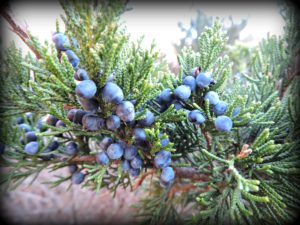
Getting Started
Eastern redcedar is a great beginner forager food to start with because the trees are very common in Virginia, periodically produce a lot of berries that can be collected quickly and these trees are easy to identify. Plus, they are eaten by almost 50 different species of wild birds and mammals! The berries rank 19th on our Best Berries List.
What rehabber wouldn’t want a stash of juniper berries in the freezer for when the waxwings pop in?
In addition to Virginia’s two native species, there are many cultivated juniper species which can come in many forms from low, ground-hugging shrubs to upright tall trees, but one of them may be toxic, so I suggest just collecting from eastern redcedar. The other native tree we have is common juniper, but this species is threatened in some parts of Virginia and other states, so I do not recommend collecting from it.
Of the many cultivated juniper species that people plant is yards and landscaped gardens, berries from one of these species, J. Sabina and J. oxycedrus, are considered toxic to people, so I am uncertain how it would affect animals. They are non-native landscape trees sold at nurseries under different subspecies (cultivars)—such as J. sabina ‘Mini Arcade’ and J. sabina ‘Buffalo’ and others. If you cannot verify your identification of a landscape ornamental juniper you are thinking of utilizing, then it might be best to stick with only harvesting off wild native eastern redcedars (Elpel, 2013).
Our Virginia junipers are listed below. Both are in the Cypress family. Here’s the taxonomy:
Cupressaceae (Cypress family)
Juniperus ( Juniper genus)
| Common name | Virginia Juniperus Species | Origin | Rare Plant Status |
| common juniper | J. communis | native | Globally secure, but critically imperiled in Virginia. |
| eastern redcedar | J. virginiana | native | Not rare |

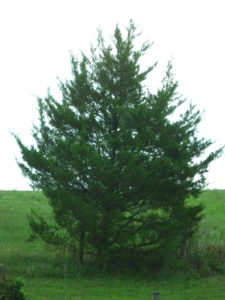
Key Features to Look For
In addition to the identification guide of your choice, here are a couple of features you should see on eastern redcedar tree:
- Trees are 40-50 feet tall when mature and bearing fruit
- Evergreen, conifer tree
- Female trees have the blue berries, male trees have very small brown cone-looking structures that sometimes put out a prodigious quantity of pollen–clouds of it!
- Berries are round pea-sized, blue-black with a whitish film
- Needles are pointy and prickly in a young tree, but in the mature tree that bears fruit—the needles are scaly and not sharp to the touch
- Bark is a light reddish- brown- orange with long strips that peel off
- Sometimes you’ll see cedar-apple rust on cedar trees. This is a plant pathogen that can occur where apple trees and redcedars are in close proximity. You may see these dramatic growths.
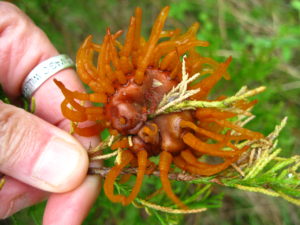
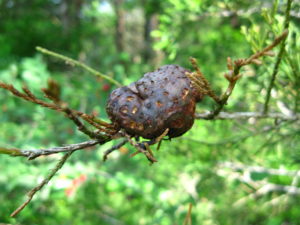
Risks
Exposure to eastern redcedar needles can cause contact dermatitis in some humans. Large quantities of Juniperus spp. browse can cause abortion or other toxic effects in cattle and sheep. Redcedar fruits (cones) are considered safe except in large quantities. (Burrows, G.E. & Tyrl, R.J., 2013; Douglas, 2004)
About this Species
Redcedar’s resinous scent is feels warming to me when I smell it on a cold winter day. This very common tree pioneers newly cleared land, so it grows often in large stands for many years in an old pasture until the hardwoods eventually grow up and replace the cedars. I often squint into the treetops trying to locate the cedar waxwing flocks I periodically hear buzzing up high in cedar woods.
Not every eastern redcedar you find will bear fruit because this tree is dioecious—male and female reproductive parts are on separate trees and only female trees bear fruit. Around my house. there always seems to a disproportionate amount of trees in any given year with no fruit, so I keep an eye out for what will be my fall-winter harvest trees starting mid-summer.
Flower Description: The flowers on the male trees are a yellow brown color. The flowers of female tree is a barely distinguishable part of the scale which turns into light blue green cone that ripens into the fruit in fall and winter.
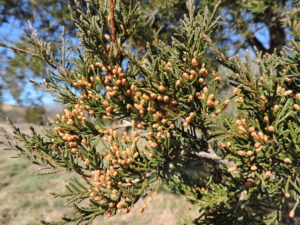
Leaf Description: Needles are pointy and sharp in a young tree, but in a mature tree the needles and stems of small twigs have overlapping scales, like fish scales, and are softer.
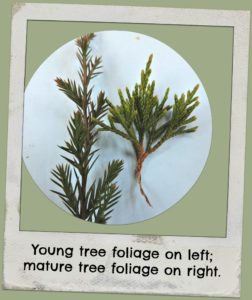
Seed/ Fruit Size: Fruit is blue-black and round with a whitish film covering. The berries, vary a little in size on a tree, averaging around 3/16 inch (5 mm) in diameter. They cluster mostly around the branch. The seed within is about 1/8 inch (3-4 mm) long. There will be two yellow-tan to bluish seeds inside each fruit and the thin interior flesh of the fruit is green.
Juniper berries have a long window of harvest into winter, but eventually the cones do dry out and crumble. In heavy fruit years, the fruits will drop to the ground. When a tree is particularly heavily laden with fruit, I can pick just the “low hanging fruit” and get about 2 quarts in a few hours from a stand of several trees. You want to collect when the fruit is mature but still firm and not crumbly. Mature berries will be a dark lavender-blue color with a whitish film. Even when there are blue cones on the trees there will also be lighter blueand greenish berries on the tree as well, so you will probably end up harvesting a mix. As long as the cones separate easily from the branch, they can be considered ready to harvest.
The fruit looks like a berry, but is actually a cone. Redcedar is a conifer, after all, so the fruit is a modified cone with scales. Looking closely with a hand lens, you may be able to see the cone’s bumps indicating scales hugged in tightly on the fruit.
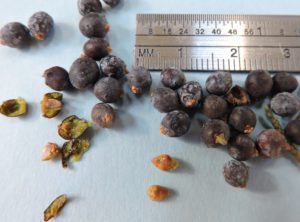
Harvesting
| Jan | Feb | Mar | Apr | May | Jun | Jul | Aug | Sep | Oct | Nov | Dec | ||||||||||||||
|---|---|---|---|---|---|---|---|---|---|---|---|---|---|---|---|---|---|---|---|---|---|---|---|---|---|
| winter | winter | late winter | early spring | spring | late spring | early summer | summer | late summer | early fall | fall | late fall | ||||||||||||||
| fruit | x | x | x | x | x | x | x | x | x | ||||||||||||||||
| browse | x | x | x | x | x | x | x | x | x | x | x | x | x | x | x | x | x | x | |||||||
Does this lend itself as a good enrichment item? Yes. Branches can be pruned with the mature berries attached and installed in enclosures.
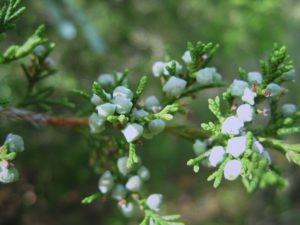
Nutrition: According to U.S. Department of Agriculture’s Michelle Anderson, eastern redcedar browse is considered of low quality, but it is high in calcium. The redcedar fruits are considered “high in crude fat and crude fiber, moderate in calcium, and high in total carbohydrates.”
Harvesting Fruit
Hand pick the berries, it’s not difficult. Bend a heavy-laden branch over a large grocery bag and rub the fruit cluster off with your other hand. In the summer you can find and note trees with immature pale yellow-green berries on a female tree so you can come back for harvest when the berries are mature. The berries are slow to ripen to the dusty dark lavender-blue you want to pick. They should easily detach from branch when ripe.
How to Store Prepared Fruit
Since juniper berries are not a fleshy fruit at all–they are a cone– they store well in baggies, jars or plastic containers in the refrigerator for many weeks.
They do freeze well, because they are low in moisture so do not turn to mush in the freezer. Package them into tightly sealed glass jars or thick, zipping freezer baggies (usually 3 mils thick or greater ) to keep them from drying out in the freezer. Remove as much air as possible from the baggie and store in freezer until needed.
See more detailed instructions.
Harvesting Browse
Browse as a term used on this website refers to the twigs and small branches, with or without leaves or needles, of trees, shrubs, vines and other woody stemmed plants. Browse can also refer to bark, for the animals that gnaw on bark.
The best time to harvest browse for the health of the tree is late fall to winter, but that may not be when you need the browse. The best limbs to remove are ones that rub together and cause abrasions that can make the tree vulnerable to insect damage. Or, cut branches that are overcrowded or hang low to the ground. Prune branches back to the base where the branch meets the trunk to minimize future insect damage to the tree.
Dip pruning shears into a bleach water solution (1:3) to minimize transferring tree diseases from one tree to the next.
Place the cut end of the browse in a bucket of water as soon as possible after cutting- ideally taking a bucket of what with you as you harvest because the branch will start to close itself off the instant it is injured. Then keep them in water as much as possible prior to feeding, which ideally means even during transport.
Browse cuttings are best fed to animals right away, they do not store well for more than a day before the leaves start to wilt and dry out, especially if it is hot. Read more about cutting browse here.
Be sure to read the section about cyanide poisoning before you harvest any browse, though eastern redcedar is not a cyanogenic plant.
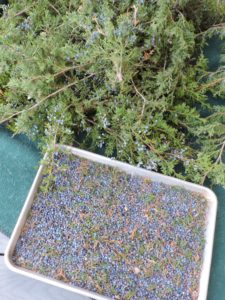
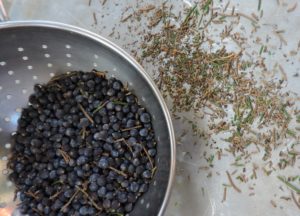
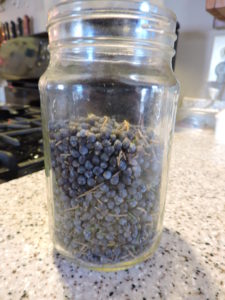
Other Juniper Species: Common juniper (J. communis) is a critically imperiled tree in Virginia. It can grow upright, but often stays low as a shrub—which is one notable difference from redcedar which grows as an upright tree. But a more reliable difference is that common juniper retains sharp needles even when mature.
Again, The two toxic junipers that should not be fed to animals are berries or foliage from J. sabina and J. oxycedrus (Elpel 2013). J. sabina is a nursery ornamental landscape plant sold throughout the U.S.A. J. oxycedrus is a southern European tree that I believe only exists in a limited number of places in California and Colorado. Avoid it as well.
Rare Juniper Species in Virginia
Do you live in one of these Virginia counties listed below? If so, be aware that there are some species near you that may be threatened or endangered. Do more research to make sure you are identifying your target species correctly and not harvesting a threatened species.
| County in Virginia | Rare Juniperus Species |
| Bath | J. communis |
| Brunswick | J. communis |
| Caroline | J. communis |
| Floyd | J. communis |
| Grayson | J. communis |
| Highland | J. communis |
| Patrick | J. communis |
| Rockingham | J. communis |
(Townsend, John F., 2015)
Feed Redcedar to:
juniper | (Juniperus spp.) | browse/bark |
|---|---|---|
 Caution: Large quantities of Juniperus spp. browse can cause abortion or other toxic effects in cattle and sheep. Needles can cause contact dermatitis in humans.(Burrows, G.E. & Tyrl, R.J., 2013; Douglas, 2004) | ||
Deer, White-tailed | Odocoileus virginianus |
|
Hare, Snowshoe | Lepus americanus |
|
Moose | Alces americanus |
|
juniper | (Juniperus spp.) | fruit |
 Caution: Juniper fruits considered safe except in large quantities.Needles can cause contact dermatitis in humans.(Burrows, G.E. & Tyrl, R.J., 2013; Douglas, 2004) | ||
Coyote | Canis latrans | strong preference |
Bear, American Black | Ursus americanus |
|
Cottontail, Eastern | Sylvilagus floridanus |
|
Fox, Eastern Gray | Urocyon cinereoargenteus |
|
Fox, Red | Vulpes vulpes |
|
Hare, Snowshoe | Lepus americanus |
|
Opossum, Virginia | Didelphis virginiana |
|
Raccoon, Northern | Procyon lotor |
|
Skunk, Spotted | Spilogale putorius |
|
Skunk, Striped | Mephitis mephitis |
|
Squirrel, Eastern Fox | Sciurus niger |
|
Blackbird, Red-winged | Agelaius phoeniceus |
|
Bluebird, Eastern | Sialia sialis |
|
Cardinal, Northern | Cardinalis cardinalis |
|
Chickadee, Black-capped | Poecile atricapilla |
|
Cowbird, Brown-headed | Molothrus ater |
|
Crossbill, Red | Loxia curvirostra |
|
Crossbill, White-winged | Loxia leucoptera |
|
Crow, American | Corvus brachyrhynchos |
|
Dove, Mourning | Zenaida macroura |
|
Finch, House | Carpodacus mexicanus |
|
Finch, Purple | Carpodacus purpureus |
|
Flicker, Northern | Colaptes auratus |
|
Flycatcher, Alder | Empidonax alnorum |
|
Flycatcher, Willow | Empidonax traillii |
|
Grosbeak, Evening | Coccothraustes vespertinus |
|
Kingbird, Eastern | Tyrannus tyrannus |
|
Kinglet, Ruby-crowned | Regulus calendula |
|
Mockingbird, Northern | Mimus polyglottos |
|
Nuthatch, White-breasted | Sitta carolinensis |
|
Phoebe, Eastern | Sayornis phoebe |
|
Robin, American | Turdus migratorius |
|
Sapsucker, Yellow-bellied | Sphyrapicus varius |
|
Sparrow, Fox | Passerella iliaca |
|
Sparrow, Song | Melospiza melodia |
|
Sparrow, White-throated | Zonotrichia albicollis |
|
Starling, European | Sturnus vulgaris |
|
Swallow, Tree | Tachycineta bicolor |
|
Thrasher, Brown | Toxostoma rufum |
|
Thrush, Hermit | Catharus guttatus |
|
Thrush, Swainson's | Catharus ustulatus |
|
Bobwhite, Northern | Colinus virginianus |
|
Grouse, Ruffed | Bonasa umbellus |
|
Grouse, Sharp-tailed | Tympanuchus phasianellus |
|
Pheasant, Ring-necked | Phasianus colchicus |
|
Turkey, Wild | Meleagris gallopavo |
|
Book References
Burrows, G.E., Tyrl, R.J. (2013) Toxic Plants of North America, 2nd Edition, Oxford, U.K.: John Wiley & Sons, Inc.
Elpel, T.J. (2013) Botany in a Day (APG). Pony, Montana: Hops Press, LLC.
Martin, A.C., Zim, H.S., Nelson, A.L. (1951). American Wildlife and Plants: A Guide to Wildlife Food Habits. New York: Dover Publications.
Scott, M. (2013). Songbird Diet Index. National Wildlife Rehabilitators Association, St. Cloud, MN.
Townsend, J. F. (2015, April) Rare Plants Natural Heritage Technical Report 15-10. (Unpublished Report) Richmond, Virginia: Virginia Department of Conservation and Recreation, Division of Natural Heritage.
Virginia Department of Forestry (2010). Common Native Trees of Virginia: Tree Identification Guide
Online References
Anderson, Michelle D. 2003. Juniperus virginiana. In: Fire Effects Information System, [Online]. U.S. Department of Agriculture, Forest Service, Rocky Mountain Research Station, Fire Sciences Laboratory (Producer). Available: http://www.fs.fed.us/database/feis/ [2017, January 11].
Douglas, S.M. (2004, September) Plants reported to cause dermatitis. The Connecticut Agricultural Experiment Station. Retrieved January 6, 2017 from http;//www.ct.gov/caes
USDA, NRCS. 2015. The PLANTS Database (http://plants.usda.gov, 6 November 2015). National Plant Data Team, Greensboro, NC 27401-4901 USA.
Virginia Botanical Associates. (Accessed November 2015). Digital Atlas of the Virginia Flora (http://www.vaplantatlas.org). c/o Virginia Botanical Associates, Blacksburg.
